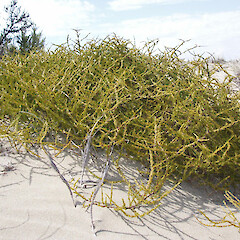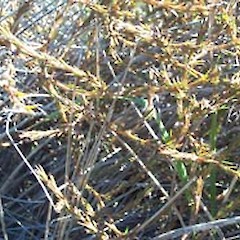Coprosma acerosa
Common name
sand coprosma, tātaraheke
Family
Rubiaceae
Flora category
Vascular – Native
Endemic taxon
Yes
Endemic genus
No
Endemic family
No
Structural class
Trees & Shrubs - Dicotyledons
NVS code
The National Vegetation Survey (NVS) Databank is a physical archive and electronic databank containing records of over 94,000 vegetation survey plots - including data from over 19,000 permanent plots. NVS maintains a standard set of species code abbreviations that correspond to standard scientific plant names from the Ngä Tipu o Aotearoa - New Zealand Plants database.
COPACE
Chromosome number
2n = 44
Current conservation status
The conservation status of all known New Zealand vascular plant taxa at the rank of species and below were reassessed in 2017 using the New Zealand Threat Classification System (NZTCS) – more information about this can be found on the NZTCS website. This report includes a statistical summary and brief notes on changes since 2012 and replaces all previous NZTCS lists for vascular plants.
Please note, threat classifications are often suggested by authors when publications fall between NZTCS assessment periods – an interim threat classification status has not been assessed by the NZTCS panel.
- Conservation status of New Zealand indigenous vascular plants, 2017 . 2018. Peter J. de Lange, Jeremy R. Rolfe, John W. Barkla, Shannel P. Courtney, Paul D. Champion, Leon R. Perrie, Sarah M. Beadel, Kerry A. Ford, Ilse Breitwieser, Ines Schönberger, Rowan Hindmarsh-Walls, Peter B. Heenan and Kate Ladley. Department of Conservation. Source: NZTCS and licensed by DOC for reuse under the Creative Commons Attribution 4.0 International licence.
2017 | At Risk – Declining | Qualifiers: PD
Previous conservation statuses
2012 | At Risk – Declining | Qualifiers: DP
2009 | At Risk – Declining | Qualifiers: DP
2004 | Not Threatened
Brief description
Sprawling yellowish small-leaved shrub inhabiting coastal areas. Twigs orange, slightly fuzzy at tip. Leaves narrow, small, with dark line down middle on the underside, in clusters of pairs scattered along twigs. Flowers tiny, with long protruding threads. Fruit white to pale blue, often flecked.
Distribution
Endemic. North Island, South Island, Stewart Island/Rakiura and Chatham Islands
Habitat
Coastal sands throughout distribution.
Wetland plant indicator status rating
Information derived from the revised national wetland plant list prepared to assist councils in delineating and monitoring wetlands (Clarkson et al., 2021 Manaaki Whenua – Landcare Research Contract Report LC3975 for Hawke’s Bay Regional Council). The national plant list categorises plants by the extent to which they are found in wetlands and not ‘drylands’. The indicator status ratings are OBL (obligate wetland), FACW (facultative wetland), FAC (facultative), FACU (facultative upland), and UPL (obligate upland). If you have suggestions for the Wetland Indicator Status Rating, please contact: [Enable JavaScript to view protected content]
UPL: Obligate Upland
Rarely is a hydrophyte, almost always in uplands (non-wetlands).
Detailed description
Low-growing, shrub with slender flexible, sprawling to prostrate, interlacing branches and branchlets, forming a more or less cushion-like mass up to 2 m across, and occasionally up to 2 m tall when supported (mostly low in stature). Branchlets numerous with orange-brown bark, pubescent when young. Leaves in opposite pairs or fascicles, on yellowish petioles. Stipules rounded-obtuse to broadly triangular, more or less pubescent, ciliolate, sometimes with 1 or more tiny dark denticles. Lamina coriaceous, yellowish green, linear obtuse, 7–12 × 1–1.5–(2) mm; midrib alone evident. Flowers solitary, terminal on short branchlets; male flower with calyx non-existent or vestigial, corolla funnelform, lobes ovate-oblong, subacute, more or less equal to tube; female flower with acute, narrow-triangular calyx-teeth; corolla funnelform, lobes narrow-oblong, obtuse. Drupe translucent, very pale to pale blue, often with darker flecks, globose, subglobose or broadly oblong, approximately 5–7 mm diameter.
Manaaki Whenua Online Interactive Key
Similar taxa
Coprosma brunnea more open habit, less leaves, only found inland in South Island, not thought to overlap naturally due to habitat requirements.
Coprosma rugosa is a taller and much more upright shrub with stiff, erect branchlets.
Coprosma intertexta is bushy but not stiffly erect; the leaves are sharp-tipped in outline and usually red-margined.
Plagianthus divaricatus has alternate, not opposite, leaves or leaf clusters, dark brown bark and dark green leaves.
Flowering
(September)–October–November
Fruiting
February–March–(July)
Life cycle
Fleshy drupes are dispersed by frugivory (Thorsen et al., 2009).
Threats
Rapidly becoming scarce in large parts of its range through dune reclamation, competition from marram grass (Ammophila arenaria) and browsing by lagomorphs. Seems to respond well to control of weeds and lagomorphs.
Etymology
coprosma: From the Greek kopros ‘dung’ and osme ‘smell’, referring to the foul smell of the species, literally ‘dung smell’
acerosa: From the Latin acus ‘sharp’, meaning sharp or pointed
TAXONOMIC NOTES
Wilson & Galloway (1993) suggest prostrate forms known as C. brunnea do not represent a distinct species.
A natural hybrid exists, C. acerosa × C. repens which is known as C. ‘×Kirkii’ and is often for sale in commercial nurseries.
Attribution
Description adapted by M. Ward from Allan (1961) and Wilson & Galloway (1993).
References and further reading
Allan HH. 1961. Flora of New Zealand, Volume I. Indigenous Tracheophyta: Psilopsida, Lycopsida, Filicopsida, Gymnospermae, Dicotyledones. Government Printer, Wellington, NZ. 1085 p.
Thorsen MJ, Dickinson KJM, Seddon PJ. 2009. Seed dispersal systems in the New Zealand flora. Perspectives in Plant Ecology, Evolution and Systematics 11: 285–309.
Wilson HD, Galloway T. 1993. Small-leaved shrubs of New Zealand. Manuka Press, Christchurch, NZ. 305 p.























